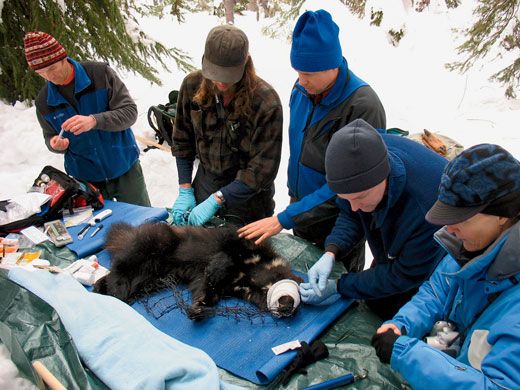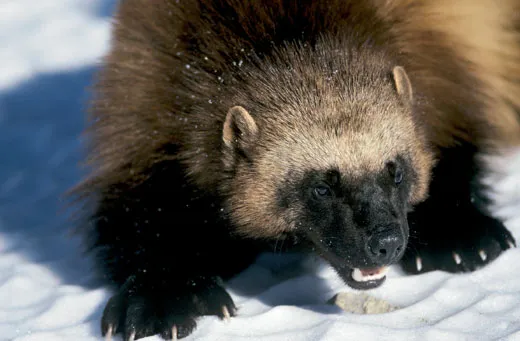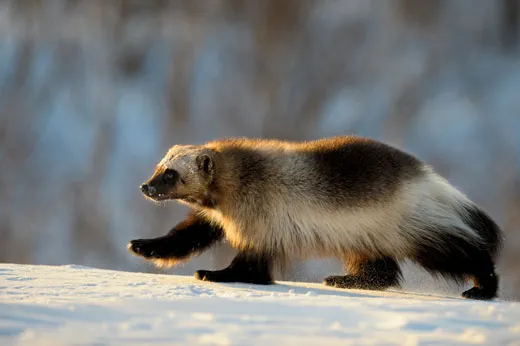The Way of the Wolverine
After all but disappearing, the mammals are again being sighted in Washington’s Cascade Range
Seven biologists and I crunch through the snow in the Cascade Range about 100 miles northeast of Seattle. Puffs of steam shoot from our noses and mouths as we look for a trap just off the snow-buried highway. The trap is a three-foot-tall, six-foot-long box-like structure made of tree trunks and branches. Its lid is rigged to slam shut if an animal tugs on the bait inside. When we find it, the lid is open and the trap unoccupied, but on the ground are four large paw prints. We cluster around them.
“Putative, possible or probable?” someone asks.
Keith Aubry glances at the tracks. “Putative,” he says. “At best.” He says they’re probably from a dog.
We were hoping they had been made by a wolverine, one of the most elusive and least understood mammals in North America. Up to four feet long and 40 pounds, wolverines are the largest terrestrial members of the mustelid, or weasel, family. Wolverines thrive in the cold, and can sniff out carcasses through six feet of snow. They raise their kits in caves dug into snow, with chambers and tunnels leading dozens of feet away from the den. Their feet are outsize, like snowshoes, and they can walk 50 miles or more per day across steep, snowy terrain. And they can be awfully hard to find.
We shuffle back to the trail and head deeper into the Okanogan-Wenatchee National Forest. There is a slight air of letdown among the field crew, but Aubry is hopeful. He nods to the high dusted peaks, the scatter of trees. “This is wolverine country,” he says.
Aubry, a biologist with the U.S. Forest Service, couldn’t have made that claim just 20 years ago. Trapped for their fur, poisoned by bait meant for wolves or regarded as pests and shot on sight, wolverines all but disappeared from these mountains in the mid-1900s. Several were caught or seen in the eastern part of Washington over the decades, but biologists believed those animals were strays that had crossed over from Montana or southern Canada, where they are far more numerous. (Wolverines also live in the boreal forests and tundra of Europe and Asia.)
Then came a blurry photograph of a wolverine in north-central Washington in 1996, and a report of a young female hit by a car in 1997. In 1998, Scott Fitkin, of the Washington Department of Fish and Wildlife, and John Rohrer, of the Forest Service—both are in today’s wolverine scouting party—set up camera traps not far from where we are now and photographed several wolverines, suggesting the furtive creatures had returned.
Wolverines have always been mysterious and, to many people, menacing. Such was its gluttony, a Swedish naturalist wrote in 1562, that after coolly dispatching a moose, the wolverine would squeeze itself between closely growing trees to empty its stomach and make room for more food. The popular 19th-century book Riverside Natural History called it an “inveterate thief” that ransacked cabins and stole bait from trap lines set for fur animals. Even as recently as 1979, the wolverine was, to a Colorado newspaper, “something out of a nightmarish fairy tale.”
These days, Aubry calls it “powerful,” “fearless” and “indomitable.” Like all mustelids, it is carnivorous; it preys on a variety of animals, from small rodents to the occasional snow-bound moose. But primarily it scavenges, at least in winter, digging into the snow to unearth carcasses and biting into frozen meat and bone with its powerful jaws. It lives eight to ten years in the wild and up to 17 in captivity. But elements of its basic biology and behavior are still unknown, in part because of its forbidding habitats.
After a jarring snowmobile ride and a slog down a slope of softer, deeper snow, we reach one of the remote camera stations that Rohrer has scattered throughout a 2,500-square-mile study area. This one is in a small copse of evergreens. A deer head hangs from a cable and is oddly mesmerizing as it twists in the breeze. Beneath it, a wooden pole juts from a tree trunk. The idea is that a wolverine will be drawn to the fragrant carrion and climb out on the pole. But the bait will be just out of reach, and so the wolverine will jump. A motion-sensitive camera lashed to a nearby tree will photograph the wolverine and, with luck, document the buff markings on its throat and chest, which Aubry uses to identify individuals.
That’s the plan, at any rate.
“Mostly we get martens,” Rohrer says of the wolverine’s smaller cousin.
To see whether the wolverine really had re-established itself in the Pacific Northwest, Aubry, Rohrer and Fitkin laid three traps in 2006 and baited them with roadkill.
“We weren’t expecting much,” Aubry says. “We thought we’d be lucky if we caught even one wolverine.”
They caught two: a female, which they named Melanie, and a male, Rocky. Both were fitted with satellite collars and sent on their way. But Melanie’s collar fell off and Rocky’s was collected when he was recaptured a few months later. The second year, the crew collared three wolverines: Chewbacca (or Chewie, so named because he nearly gnawed his way through the trap’s wooden walls before the field crew could get to him), Xena and Melanie (again). The third year, they caught Rocky twice, and the fourth year they caught a new female, Sasha.
Data detailing the animals’ locations trickled in, and by March 2009 Aubry had an idea of the ranges for several wolverines. They were huge: Rocky covered more than 440 square miles, which sounds impressive until compared with Melanie, who covered 560 square miles. Both crossed into Canada. Yet their recorded travels were dwarfed by those of Chewie (730 square miles) and Xena (760 square miles)—among the largest ranges of wolverines reported in North America. More important, though, was that Aubry suspected Rocky and Melanie might be mates, and perhaps Chewie and Xena, too, given how closely their ranges overlapped. A mated pair could indicate a more stable—and potentially increasing—population.
Working with colleagues in the United States, Canada, Finland, Norway and Sweden, Aubry confirmed that the key to wolverine territory was snow—more precisely, snow cover that lasted into May. Every single reproductive den in North America, as well as about 90 percent of all wolverine activity in general, was in sites with long-lasting snow cover.
Scientists working in the Rocky Mountains then found that snow cover even explained the genetic relationships among wolverine populations. Wolverines interbreed along routes that go through long-lasting snow.
“We have a better sense of what they need, where they like to live,” Aubry says now of the wolverines in the North Cascades. “But no one can say with any certainty how many we have here.”
He points to a string of tracks running along the side of the road. “That 1-2-1 pattern, that’s classic mustelid. And look how big they are.”
We gather around. These tracks are the only sign we’ll see of the wolverine, but for Aubry that’s how things usually go. “Most of our contact is like this,” he says. “Very indirect.”
Cathy Raley, a Forest Service biologist who collaborates with Aubry, carefully carves one footprint from the snow with a big yellow shovel and holds it out, like a cast. Aubry guesses the tracks are probably two or three days old, judging by their crumbling edges and the light dusting of snow on top of them. It’s worth knowing where the tracks go—maybe to find some hair or scat, something that could be analyzed to determine if they were made by a previously identified animal. So we follow them, looking after them as far as we can, as they wend across the soft relief of the hillside, until they disappear into the broken forest.
Eric Wagner has written for Smithsonian about cranes in Korea and sperm whales near Mexico.


